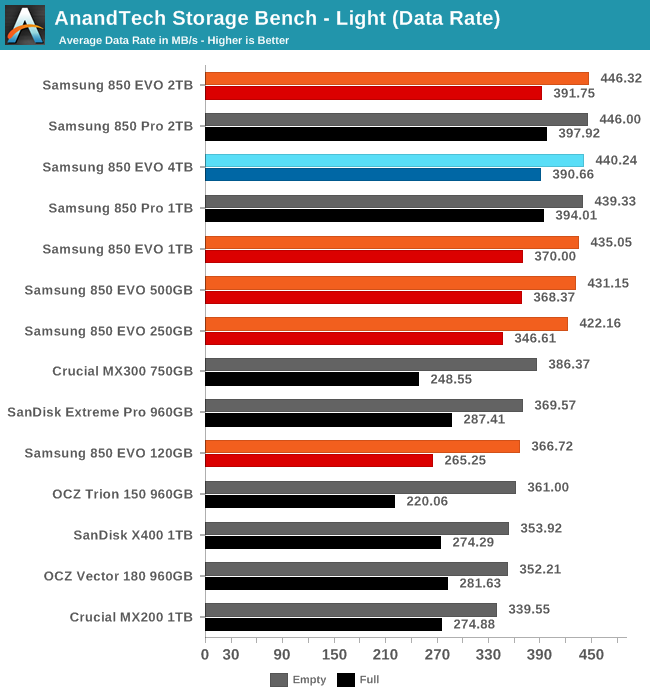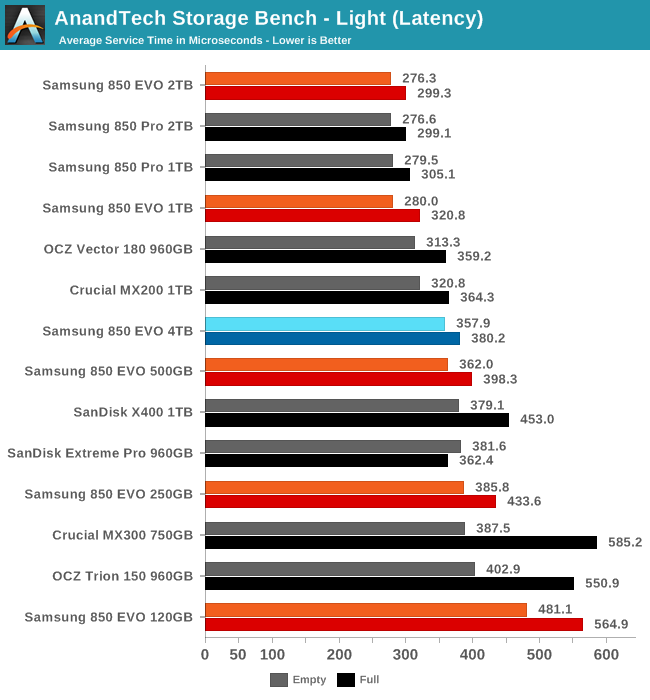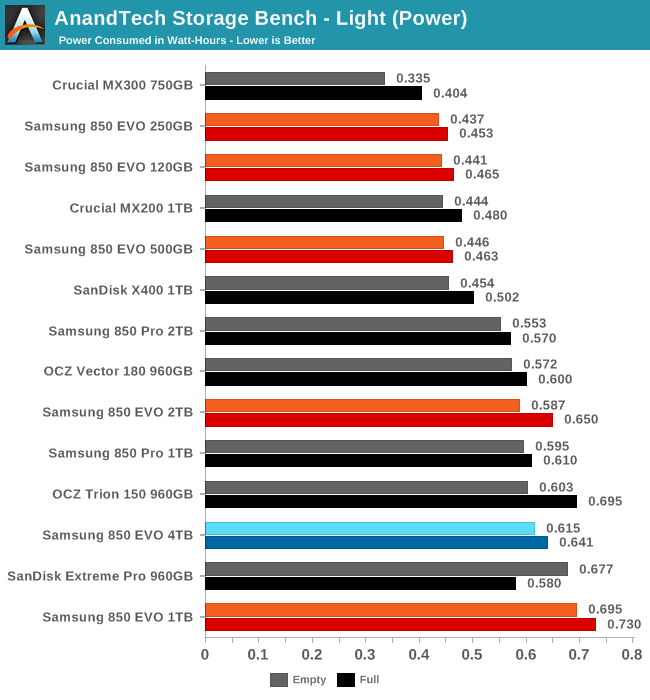The Samsung 850 EVO 4TB SSD Review
by Billy Tallis on July 11, 2016 10:00 AM ESTAnandTech Storage Bench - Light
Our Light storage test has relatively more sequential accesses and lower queue depths than The Destroyer or the Heavy test, and it's by far the shortest test overall. It's based largely on applications that aren't highly dependent on storage performance, so this is a test more of application launch times and file load times. This test can be seen as the sum of all the little delays in daily usage, but with the idle times trimmed to 25ms it takes less than half an hour to run. Details of the Light test can be found here.

The 4TB 850 EVO is in a four-way tie for highest average data rate, and the Samsung drives in general score very well and quite close to the SATA interface limits.

The 4TB 850 EVO's average service time is not top notch, but is still reasonable for a high-end SATA drive.

Once again the latency of the 4TB isn't the best and isn't quite as good as the 1TB and 2TB counterparts, but it's still better than all the other TLC drives.

The power usage of the 4TB EVO is a bit worse than the 2TB model when fresh but is slightly better for a full drive, showing that this drive isn't worth having if you're barely going to use it.










145 Comments
View All Comments
nandnandnand - Monday, July 11, 2016 - link
Weren't the first XPoint parts going to be 16-32 GB? I find $0.65/GB hard to believe... I expect $3.00/GB.nathanddrews - Monday, July 11, 2016 - link
Yeah, I'll believe it when I see it.Kevin G - Monday, July 11, 2016 - link
Where are you seeing this and for what format?I strongly suspect that Intel is going to be price competitive in the NVMe space so that's realistic but I'd expect a massive premium for Xpoint in DIMM format when Skylake-E comes around.
shabby - Monday, July 11, 2016 - link
Why would xpoint dimm be premium priced? They said its slower than dimm, so it should be cheaper.Kevin G - Monday, July 11, 2016 - link
Well what competition would the DIMM format have on SkyLake-E?SATA based SSDs are a dime a dozen and M.2 drives using NVMe are just starting to spread. What competition would Intel have with a DIMM format?
Impulses - Monday, July 11, 2016 - link
There's a lot of pie in the sky dreaming about Xpoint IMO... Why would it be priced at a premium? Same reason M.2 NVMe & PCI-E drives are, it's what the market will bear that counts. If it's any faster it'll be more expensive, simple really.ddriver - Monday, July 11, 2016 - link
Don't hold your breath. They made claims of "ram" speed, but demoed 2 GB/s hardware, which is not much faster than nvme SSDs. Ram is 20-30 GB/s...SSDs can still go a long way in terms of bandwidth - just snap more chips on more channels, given an available interface to hook it to, it would be too much trouble for the industry to create something like 8 GB/s SSD. And it only requires a better controller chip, can work with the same old flash memory chips. Currently, M2 can only provide theoretical 4 GB/s bandwidth, running at 32 gbit.
Eden-K121D - Monday, July 11, 2016 - link
a PCIe gen4 device could have potential read speeds of 8GB/sKevin G - Monday, July 11, 2016 - link
The 2 GB/s demo was using a Thunderbolt enclosure and an M.2 prototype.Full size PCIe and DIMM formats are planned so I'd consider that 2 GB demo the starting point.
benedict - Monday, July 11, 2016 - link
Horrible write endurance. If you need a drive that big you certainly have enough data to fill it 75 times.